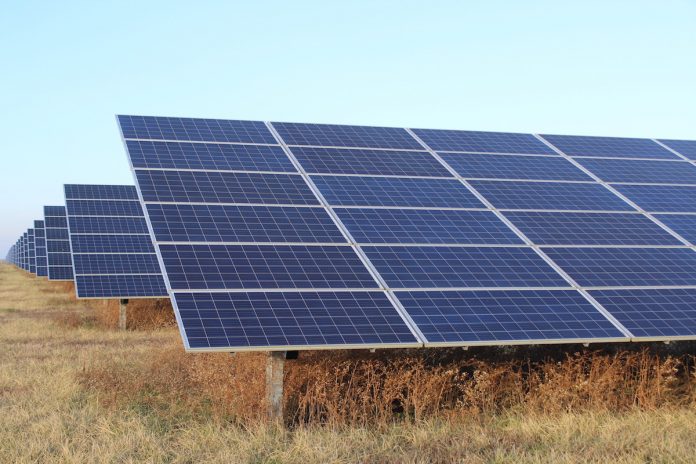Supporters of renewable energy and private property rights are unhappy with changes made to an Ohio Senate bill that proposes giving locals the power to approve utility-scale solar and wind projects.
Instead of setting up a referendum process for residents to approve each large renewable energy project, the sub bill added onto Senate Bill 52 and House Bill 118 would let townships set aside certain areas of the community for wind and solar development.
The new mechanism for local control, announced last week during the House Public Utilities committee, was created in part to address concerns from the renewables industry that the original bill would have resulted in a de facto moratorium on large-scale wind and solar development, said Sen. Rob McColley, cosponsor of SB 52. The solar industry, though, says it was not involved in the drafting of the sub bill.
“It would result in lost jobs, lost revenues, and unfairly harm businesses, workers and farmers,” said Jason Rafeld, executive director of the Utility Scale Solar Energy Coalition, in a statement. “The bill was job-killer to begin with, but last week, behind closed doors, the Ohio Senate redrafted a substitute bill that is no better.”
Opponent and proponent testimony and discussion on the legislation went on for three hours May 19 during the Senate Energy and Public Utilities committee. More than 80 people submitted testimony, including many farmers who are against the bills.
The original language of House Bill 118 and Senate Bill 52 would have created a referendum process by which locals would approve utility-scale solar and wind projects before they went to the Ohio Power Siting Board.
The sub bill would instead allow townships to create a resolution designating certain parts of the township as “energy development districts” where large wind and solar farms could be built. The district could contain the entire township or only parts of it, McColley said.
The creation of such districts would be subject to a referendum. Under the proposed legislation, the Ohio Power Siting Board could not grant a certificate to a facility unless it was located in an energy development district of a municipality.
Battle
This issue, like many issues surrounding renewable energy in Ohio, has become a battle over local control, private property rights and economic development.
Supporters of the bill say the public input process through the Ohio Power Siting Board isn’t effective. The current process allows for residents to provide five minutes of testimony during a public hearing, but most projects are certified regardless of significant public opposition to it. They also point to other states where such energy projects are permitted at the local and county level.
The solar industry continued to rail against the legislation, saying it would drive the utility-scale industry, and with it potentially billions of dollars in investment, from the state. Developers also argue the process to get approval in Ohio is rigorous enough. In most cases, a solar project is developed for months, or even years, before an application is filed with the Ohio Power Siting Board.
Farmers found themselves on both sides of the bill, with many testifying against it.
Connie and Arthur Schoultheis, dairy farmers in Highland County, both submitted testimony opposing the bill, saying it would take away their right to put their land in a solar development. The Schoultheises put half their acreage into the Willowbrook solar project. Solar will be a way they can retire from their dairy farm.
“I like to say, we have always worked the ground, and now the ground is going to work for us,” Connie Schoultheis said. “Senate Bill 52 is unfair because it penalizes the farmer. We pay the mortgage, insurance and taxes on our farm land. This is our land to do with what we please. I support private property rights, and if you do as well then you should be against Senate Bill 52.”
The Ohio Pork Council, International Brotherhood of Electrical Workers and the Affiliated Construction Trades Ohio also testified against the bill May 19.
Targeted
There’s also the question of whether renewables are being unfairly targeted by this legislation, something the solar industry maintains is happening. The question has come up in several committee hearings on the bills.
During the House Public Utilities committee May 12, Rep. Daniel Troy, D-Willowick, asked whether the bill created a double standard, because local governments can’t regulate oil and gas development either.
The Ohio Supreme Court ruled in 2015 that the local governments do not have the power to ban or regulate fracking through zoning laws or other restrictions. Only the state has authority over the oil and gas industry.
McColley said that comparing oil and gas to renewables was like comparing apples to oranges, in particular because the land use is so much greater with solar and wind projects. A utility-scale solar development will take up at least 350 acres, but typically much more.
“They are transforming the land use of that jurisdiction more than any other power generation asset would, including fossil fuel plants,” McColley said.
Troy contended that to a resident living next to a drilling rig, it wouldn’t matter how large it was if it was disturbing them.
“My understanding of House Bill 118 was to protect residents from having to experience the inconvenience of having a windmill or solar array near their property,” he said. “I don’t think it’s so much an apple and an orange. It might be an empire and a Jonathan apple.”
Testimony and discussion will continue on the sub bill for House Bill 118 and Senate Bill 52.










